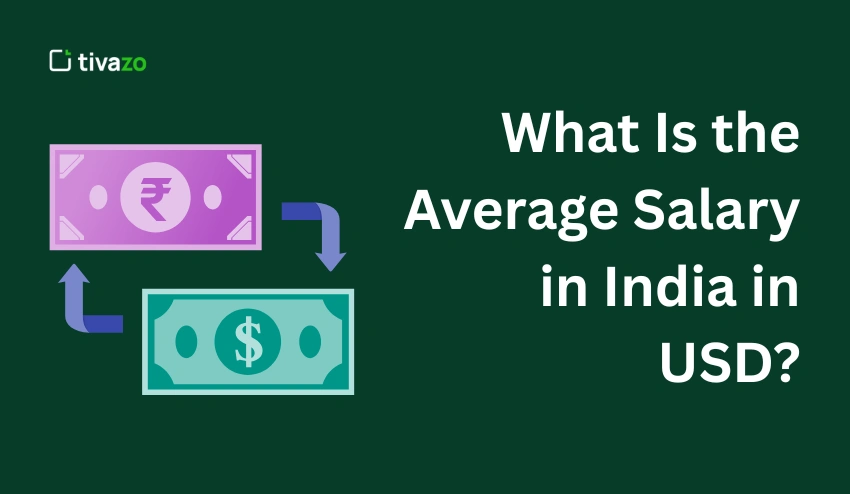In recent years, India’s economy has achieved impressive growth with extensive changes. The rapid pace of these growth has resulted in immense changes to our job and wage structures throughout India. For anyone involved in the workforce, employees, job seekers, employers, and world-wide investors, understanding India average salary in USD is now more important than ever. At the very least, it gives everyone a common perspective of pay and helps us make more informed decisions in the area of employment, hiring, and investing purposes. A more informed staffer will ultimately make smarter decisions.
This blog is aimed at providing a credible and respectable picture of average salary in India in USD now. We will canvass the predominant factors contributing to this salary average based on education level, job roles, and geographic location. We will also be looking at trends in some industries and in geographic locations around the country. In the end, we will compare India’s pay scale to other countries around the globe. While you consider your career trajectory or develop salary tactics for your own business; our guide on India average salary in USD should provide useful insight to today’s economic conditions.
Key Takeaways:
- What Is the Average Salary in India in USD?
- How Does Education Impact Salaries in India?
- Top-Paying Professions in India (2025)
- Regional Salary Variations Across India
- Salary Growth Trends and Annual Increments
- India’s Average Salary Compared to Other Countries (in USD)
- What Does This Mean for Employees and Employers?
- Conclusion
What Is the Average Salary in India in USD?

India average salary in usd indicates the rapidly developing normalcy and complexity of India’s labour market. According to the most recent statistics, average salary in India is approximately USD 4,200 annually or about USD 350 monthly, based on 2025 data. Despite not being a very precise number, it does help situate people’s earnings across the labour in the country and provides some background for understanding what is considered decent earnings in the Indian economy.
Understanding Average vs. Median Salary
It’s important to remember the distinction between average and median salary. Average salary is the gross income summed and divided by number of employees, and as a single metric it can be skewed by the extraordinarily high earners. Median salary is the value in the middle where half of the people earn more and half earn less, which is a much more practical figure for many people. In India the median salary stands at about USD 320 monthly.
Salary Range Across Industries
Salaries in India can range from very low to very high depending on what type of work is being done and the role of the person in their job. An entry level job or person in an unskilled job might be paid USD 100 per month, or a specialized profession like computer data scientist or health care management can earn upwards of USD 1500 per month of a salary. The range of salaries in this respect illustrates the diversity of opportunities and problems in the Indian job market.
How Does Education Impact Salaries in India?

Education is an important determinant of salary levels in India. Many studies and salary surveys found generally that higher education is linked to a higher income. All sectors and regions showed the same trend, which is why education is one of the most prominent determining factors of the India average salary in USD.
Salary Differences by Education level
- High School Graduates: People with only a high school diploma earn on average the lowest salaries in the labor market. They are mainly unqualified or semi-skilled positions that would normally provide no more than a minimum wage for wages. On average, in India the high school diploma weekly earnings are about USD 250 per month.
- Diploma/Certificate Graduates: People who graduate from diploma programs or have some type of technical certificate earn close to 17% more than high school graduates. They also come with a specialization that has more value to employers with technical skills or trade skills.
- Bachelor’s Degree Graduates: People’s salaries who graduate with a bachelor’s degree on average earn approximately 24% more than diploma graduates. A bachelor’s degree is more valued due to the knowledge of employability skills, college teaches more than just job-specific knowledge, but also research skills like critical thinking. Therefore, they qualify for better paying jobs that generally provide better responsibility as well.
- Masters Degree Holders: Employees with a master’s degree typically make 29% more than people with a bachelor’s degree. This is serious earning potential and as further education often provides expertise and leadership capabilities which are in high demand in competitive labour markets.
- PhD Holders: Employees with a PhD make about 23% more than employees with a master’s degree. PhDs are typically engaged in specialized fields, research, and academia. Further, their advanced knowledge warrants higher compensation levels.
Why Education Matters
Undertaking higher education will not only create earning potential but will create job opportunity which often comes with management and leadership roles. Additionally, it usually comes with greater job security, benefits, and career advancement opportunities. Employers pay for degrees because the cost is justified for these skills, and looking at education as part of the talent and job market provides meaningful benefits to businesses.
Education is a sound investment for anyone wanting to increase income and improve career opportunities. Understanding the link between education and salary is crucial when exploring the India average salary in USD, as previous reports show education is the driving force behind salary increases across all sectors .
Top-Paying Professions in India (2025)
In India, there are distinct professions that are recognized as best paying jobs, especially in demand industries such as tech, health, and management. People are drawn to the most skilled positions based on wage and development opportunities, contributing to the overall India average salary in USD.
Highest-Paid Roles and Their Salaries
- Data Scientist: As businesses increasingly rely on data to help inform their decisions, businesses want and need more data scientists, who earn around USD 11,400 a year, given the importance of interpreting and utilizing data effectively for business outcomes.
- Software Engineer: The ongoing performance of the IT sector has helped software engineers, earning about USD 9,600 a year, as there are endless opportunities for those involved in to create applications or software solutions.
- Medical Professional: Medical professionals have their specialized knowledge and often onerous responsibilities, earning about USD 12,000 a year, reflecting the importance of health care on India’s growing economy
- Mechanical Engineer: Would can work in a variety of professions including manufacturing and Industry, mechanical engineers can earn from USD 21,600 a year, one of the top of the pay bracket of engineers.
- Marketing Manager: As businesses become larger and competition increases, marketing managers have an important and valuable role in driving growth and keeping customers engaged with the business. Most marketing managers earn an estimated USD 84,000 in salary each year, making this a lucrative job in the corporate workforce.
Entry-Level vs. Experienced Salaries
Salaries for these occupations range considerably (and there are a lot of entry-level salaries lower than these). Entry-level employees may be earning an annual salary of USD 5,000 when beginning their first role when it pertains to the example of a software engineer. However, experience + expertise + skills can see their total compensation double or triple years after, which is one of the largest motivators to continuously be learning and developing in a professional sense. For that reason, it was plausible for the average salary in USD for India as a whole to increase over time.
Regional Salary Variations Across India
India has an enormous geographical size with developing economies resulting in income disparities across the nation. India average salary in USD can differ greatly based on the location from cities that are metropolitan to rural regions.
Urban vs. Rural Pay Differences
The pay in metropolitan areas such as Mumbai, Bangalore, and Delhi will be significantly higher than the same population in rural populations. Notably, these metropolitan areas have more infrastructure, jobs, and are higher in cost of living, which will in turn result to higher wages. For example, unskilled laborers in Delhi will earn approximately USD 7.31 daily minimum wage versus unskilled laborers in rural Bihar who on average may get around USD 3.63 daily. The clear gap based on development levels by regions certainly plays a role in wages compared to the India average salary in USD is across regions
State-wise Minimum Wages
- Delhi – ₹673/day (~USD 7.31) – This is among the highest regarding minimum wages due to the per capita being higher based on being a city with a capital status as well as higher cost of living
- Bihar – ₹304/day (~USD 3.63) – This will be reflective of higher cost of living and lower economic development of state
- Maharashtra & Karnataka – These states detail average monthly pay from ₹20,000–₹21,000 (~USD 240–250), especially from an urban area.
These distinctions not only highlight wage variations, but additionally emphasize the fact that the India average salary in USD is heavily influenced by geographical, economic and industry factors. Professionals working in urban centers enjoy significantly higher compensation packages often due to industry hubs and ecosystems, while professionals working in rural areas are left with lower wages tied to agriculture or informal labor which often has very few scalability options.
Salary Growth Trends and Annual Increments

A significant contributing factor to the India average salary in USD is the continuous growth in annual wages of multiple industries. In general, India sees wage increases from approximately 8.5% to 10% in various industries after one year of service with a given employer but it depends on many other factors such as industry, skill level and economic conditions.
Annual Salary Increase Percentage
Employees in both private and public sectors in India generally see annual salary increases. These increase percentages can depend on inflation, service performance and particularly industry competition. For example, an employee in India who makes USD 6,000 annually could see their wage rise USD 500 to USD 600 per year thus improve their positioning in relation to the India average salary in USD.
Factors contributing to Growth of Salaries
There are many reasons why these annual wage increases are consistently happening:
- Economic Growth: India is continuing to develop into a major global economy, more business activity is generating more demand for qualified employees thus wage increases. This is also true for urban programming and related sectors.
- Industry Demand: Industries like information technology, healthcare, and financial services have higher performance which creates higher than average annual increases in wages. Technologies in the health care and financial service industries are likely to see considerable wage increases which thus creates higher average salary in USD for India averages.
- Government Policies: Changes to minimum wages, labor laws, and reforms of job markets contribute to the overall salaries growth. For example, increases in minimum wages also raise baseline income levels for many people in the regions.
Future Salary Predictions
Looking ahead, experts expect a steady and sustainable growth in salaries over the next five years. Most wage growth is expected to be in the technology and service industries because digital remains at the forefront of transformation, and demand for Indian talent continues to be strong globally. This expected development also suggests that the average salaries in India in USD will continue to increase, primarily for skilled jobs that meet the demands for global business.
India’s Average Salary Compared to Other Countries (in USD)
When considering the India average salary in USD from a world perspective may have slaves impression of a low number, but it’s important to appreciate this number in the context of the India economic structure, cost of living and labor situation. Earnings differentials can appear stark, but they mostly illustrate social-economic circumstances as opposed to just being a reporting of value.
Salary Comparisons with Other Countries
To better understand India’s average salary level, consider the average monthly salaries of other key countries:
- United States: The US average monthly salary is roughly USD 7,900, which is nearly 18 higher than the India average salary in USD which is around USD 437.
- United Kingdom: The UK average monthly is USD 8,092 which is substantially, but not impossible, higher than India. But, the cost of living in the UK is also many times higher.
- Russia: The average monthly salary is roughly USD 1,392, which is more than three times India average salary level, but is also moderate compare with other global wage markets.
- Philippines: The average salary is USD 875, making the Philippines are much better effort to bring wage levels to India, but still many times hire in many important industries.
These disparities are not just representations of financial disparity; they also represents cost of living, currency valuation, and market expectations. Further, while it can be common to look at a salary as a metric, it’s necessary to understand that while a salary may be low when looked at from an Indian standard, purchasing power within India balances this out to a degree.
Why India Is an Outsourcing Center
One of the most significant results of the relatively low India average salary in USD is India’s prominence in the global outsourcing landscape. Businesses globally have a requirement for good quality labor that does not break the bank and feels India meets that criteria perfectly.
- The cost of living in India is about 65% lower than the United States measuring in USD; meaning employers are able to offer lower salaries and employees can have a locally considered comfortable existence.
- For example, IT managers in India earn an average of USD 1,365 per month, which is way below the salaries of his peers in China or Canada where they are more than three or four times the salaries for similar roles.
- Likewise, call center agents in India earn about USD 201 per month, compared with USD 318 per month in the Philippines – yet another top global outsourcing destination.
The cost savings are why companies continue to pour money in India for offshore IT services, BPO (Business Process Outsourcing) and KPO (Knowledge Process Outsourcing) services. When global companies compare average salaries in USD based on India salary data, this was offers average 40%-60% cost savings compared to western countries while adding a great depth of access to educated and English-speaking populations.
In addition, this trend of outsourcing is important for the Indian economy in many indirect ways. For example, as demand for services continues to increase in any economy, it increases job opportunities that require the development of skills, and overtime this will eventually push wages up as well as in the larger cities in larger “high” value-added knowledge sectors, including software development, analytics, finance and business.
What Does This Mean for Employees and Employers?

Awareness of the average salary in USD in India is important for both employees and employers in making decisions regarding their careers or hiring decisions.
For Employees
- Salary Expectations: When employees are aware of the average salary in USD, they will set a more reasonable expectation regarding the job offer and the transition to other jobs. Realistic assumptions help avoid unwarranted assumptions and help better financially plan for the transition.
- Negotiation Power: Employees that understand what their fields are paying on average in their geography helps provide employees with some advantage during the interview process and annual review process. For example, If I am aware of what average software engineers or marketing managers are making in USD terms, I can ask to be compensated appropriately.
- Career Growth: If an employee upskills themselves into an in-demand areas of work – especially in areas like IT, health, finance, etc., the likely hood of surpassing the average salary in USD is higher. In other words, up-skilling is an important part of unlocking higher salaries.
For Employers
- Competitive Packages: Employers familiar with average salary data in USD can build attractive and more competitive compensation packages. This is important to help compete for and retain talent in a globalized contextualized job market.
- Location Strategy: Employers may intentionally look for a location that has a lower average salary in USD, and also has a skill base that, they believe, has equivalent outputs. This is a location strategy for reducing overall labor costs.
- Talent Development: Investing in employee growth through training, workshops, courses, and certifications creates long-term benefits. The investment into the employees development is important to morale and known performance levels, and it clearly justifies cost of living adjustments that employers many consider on an yearly basis.
When compensation strategies mirror market expectations and employee expectations, employees and businesses are able to make better decisions, with credible and logical financial decisions for all stakeholder.
Conclusion
It is important to know India’s average salary in USD which is approximately USD 4,200 per year for both job seekers and employers. While this amount may seem small in comparison to developed countries, it should be put into context with respect to India’s cost of living, economic situation and job market. The average salary, USD and otherwise, will vary based on industry, educational level, and where you live, and underscores the need for your career planning and labour market research.
For employees, knowing approximately what the average salary is in USD allows you to have realistic expectations, takes the guesswork out of negotiating a salary, and would aid in planning your upskilling and portability options. For employers, knowing a comparable average salary allows you to make better decisions about recruitment, compensation, and optimizing costs, especially, in the context of outsourcing.
Understanding salary trends will only become increasingly important as India continues to develop economically. If you’re an employee, this salary is something to be considered as you enter the job market, and if you manage employees, there are very many considerations, but the average salary expressed in USD is something that provides insight to help you make decisions, be more satisfied in your job or more competitive in the workplace.
FAQs:
What is a good salary in India in USD?
A good salary in India in USD terms is generally considered to be between USD 10,000 and USD 15,000 a year, particularly in white collar roles - IT, finance, and management - or in metro cities. With this level of income, you would lead a comfortable lifestyle, save money, and have a higher standard of living, particularly as India's cost of living is lower than in the West.
What is the average salary in India in American dollars?
According to the latest data, the average salary in India in dollars is around USD 4,200 a year. It will depend on the profession, experience, job title, education, etc.
What is India's average income in dollars?
India's average income in dollars is roughly equivalent to its salary figure - USD 350 - 400 per month or USD 4,200 - 4,800 per year and possibly less for median income considering income disparity.
Is 30k a good salary in India?
If you are saying INR 30,000 per month (around USD 360 - 370), it is average salary in Tier 2 or Tier 3 cities but could feel restrictive in a metro city like Mumbai or Delhi. It will pay for the necessities but probably doesn't leave a lot to save and enjoy a little luxury.




